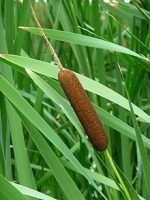 Native to marshes, swamps, and wetlands of North America, South America, Europe, Africa and Asia, this herbaceous aquatic perennial is known by many names including bulrush, cat-o’-nine-tail’s and cooper’s reed. It is a member of the Typhaeceae, a plant family that also includes bur-weed. The plant grows 4-10′ tall from a tough extensive rhizomatous root system and has a straight, erect, green, unbranched stem. The gray-green sword-like leaves are 4-7′ long and turn bright yellow in the fall. From late spring into summer tiny male and female flowers are produced in a cylindrical inflorescence with the male flowers above the female. The male flowers are golden yellow when they produce pollen while the female flowers change from green to dark brown as they ripen. The male flowers disintegrate with maturity leaving a naked stem while the densely packed fertilized female flowers give rise to single-seeded hard fruits with long slender hairs that facilitate dissemination. The inflorescences are very desirable for flower arrangements. Cattails are valuable for erosion control and as a wildlife habitat, providing shelter and food for birds, small mammals, fish and insects. They form clumps and are attractive on the edges of ponds or water gardens and can serve as a hedge or screen there, but can become invasive. The shoots, roots, and pollen are edible if properly harvested and prepared. The genus name, Typha, comes from ancient Greek τύφη (túphē),the Greek name for the plant. The specific epithet, latifolia, comes from the Latin words latus meaning broad, folia, meaning leaf.
Native to marshes, swamps, and wetlands of North America, South America, Europe, Africa and Asia, this herbaceous aquatic perennial is known by many names including bulrush, cat-o’-nine-tail’s and cooper’s reed. It is a member of the Typhaeceae, a plant family that also includes bur-weed. The plant grows 4-10′ tall from a tough extensive rhizomatous root system and has a straight, erect, green, unbranched stem. The gray-green sword-like leaves are 4-7′ long and turn bright yellow in the fall. From late spring into summer tiny male and female flowers are produced in a cylindrical inflorescence with the male flowers above the female. The male flowers are golden yellow when they produce pollen while the female flowers change from green to dark brown as they ripen. The male flowers disintegrate with maturity leaving a naked stem while the densely packed fertilized female flowers give rise to single-seeded hard fruits with long slender hairs that facilitate dissemination. The inflorescences are very desirable for flower arrangements. Cattails are valuable for erosion control and as a wildlife habitat, providing shelter and food for birds, small mammals, fish and insects. They form clumps and are attractive on the edges of ponds or water gardens and can serve as a hedge or screen there, but can become invasive. The shoots, roots, and pollen are edible if properly harvested and prepared. The genus name, Typha, comes from ancient Greek τύφη (túphē),the Greek name for the plant. The specific epithet, latifolia, comes from the Latin words latus meaning broad, folia, meaning leaf.
Type: Herbaceous aquatic perennial
Bloom: Tiny male and female flowers in cylindrical inflorescence from alte spring into summer
Size: 4-10′ H
Light: Full sun to part sun
Soil: Wet, both fresh and brackish
Hardiness: Zones 3-10
Care: Low maintenance
Pests and Diseases: None of importance
Propagation: Seed, division
Companion Plants: Calla lily, Iris pseudocorus, Canna , pickeral weed
Outstanding Selections: None available
Photo Credit: Wiktionary